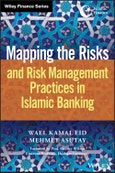Mapping the Risks And Risk Management Practices In Islamic Banking is a comprehensive analysis of the current state of risk management practices within the Islamic banking industry, with recommendations for policy makers, bankers, and industry stakeholders. Going beyond the academic, this book presents the opinions and perceptions of industry financiers and bankers, alongside primary information and data collected by Islamic finance professionals to deconstruct and analyze the sector's current risk management practices. You'll get up to date on the latest attitudes and trends, and delve into the current issues surrounding risk management in Islamic banks. With a focus on practical applications, this authoritative guide discusses the unique risks facing Islamic banks, from the perspective of a wide range of practitioners.
Risk management is one of the biggest, most controversial issues in Islamic finance, yet it remains under-researched. Many uncertainties exist for which the answers are still unclear, yet will play a large role in shaping the industry's future. This book digs deep into current ideas and practices to discover what's being done, what needs to be done, and what needs to stop happening to keep the future of Islamic finance strong.
- Explore both Islamic and traditional attitudes toward risk
- Examine current Islamic risk management practices
- Understand the latest industry issues and trends
- Consider the diverse range of risks unique to the Islamic banking sector
Effective risk management in Islamic banking deserves priority attention. Unless the industry develops its own genuine risk management architecture, it cannot achieve its full potential and the viability needed for a more resilient financial system than the debunked Wall Street model. Mapping the Risks and Risk Management Practices in Islamic Banking provides a deep, authoritative analysis of where the industry is today and where it needs to develop.
Table of Contents
Foreword xi
About the Authors xiii
Chapter 1 Introduction: Research Background and Motivation 1
Systemic Importance of Islamic Banking and Finance 3
Research Aims, Objectives and Questions 5
Research Hypotheses 6
Significance of the Study 7
Overview of the Research Methodology 9
Overview of the Research 10
Chapter 2 Principles of Islamic Banking and Finance 13
Historical Background of Islamic Banking and Finance 14
Size of the Industry 17
Principles of Islamic Banking and Finance 20
Basic Islamic Financing Contracts 20
Sukuk: A Step Toward Securitisation 25
Islamic Banking Versus Conventional Banking 31
Institutional Developments in Islamic Banking and Finance Industry 33
Conclusion 39
Chapter 3 Risk Management in Islamic Banks: A Theoretical Perspective 41
Risk Management: Basic Concepts and Techniques 44
Risk Management and the Credit Crunch 51
Classification of Risks 51
Risks Common to Both Islamic and Conventional Banks 54
Further Risk Areas Specific to Islamic Banks 93
Risk Categories are Entangled 106
Risk Management Issues in Sukuk 107
Risk Mitigation in Islamic Banking 110
Surveying Risk Management Practices in Islamic Banks: A Review of Empirical Research 120
Conclusion 123
Chapter 4 Capital Adequacy for Islamic Banks: A Survey 127
Significance of Capital in Banking 128
Classification of Capital 129
Steps in the Basel Accord 130
Basel II and Islamic Banks 138
Basel III 142
IFSB Principles on Capital Adequacy 143
Capital Adequacy as a Tool for Risk Mitigation 150
Conclusion 151
Chapter 5 Islamic Banking and the Financial Crisis 153
Understanding the Credit Crisis 156
The Financial Crisis and the Need for an Alternative System 163
The Financial Crisis and Islamic Finance and Banking as an Alternative Option 163
Deviations from the Foundational Shari’ah Principles: Evaluating the Operations of Islamic Finance 173
How to Achieve the Full Potential of Islamic Finance 177
Conclusion 181
Chapter 6 Research Framework and Methodology 183
Research Questions and Objectives 183
Research Hypotheses 185
Research Methodology 191
Research Design 191
Research Strategy 193
Research Method 194
Difficulties and Limitations 210
Conclusion 211
Chapter 7 Profiling Perspectives of Risk Dimensions in Islamic Finance: Descriptive Questionnaire Data Analysis 213
Data Analysis and Results 213
Conclusion 250
Chapter 8 Analysing Perceptions of Risk and Risk Management Dimensions and Issues: Inferential Statistical Analysis 253
Risk Perception 254
Risk Management and Reporting 295
Risk Measurement 301
Risk Mitigation 303
Islamic Banking in Practice 304
The Next Chapter in Islamic Banking 306
Conclusion 307
Chapter 9 Exploring Perceptions of Risk and Risk Management Practices in Islamic Banking: Interview Data Analysis 309
Interview Analysis 309
Forming the Main Interview Themes 310
Interview Questions 310
Results and Data Analysis 311
Conclusion 335
Chapter 10 Contextualising the Findings: An Interpretative Discussion 337
Risk Perception in Islamic Banking 337
Islamic Finance Contracts 345
Additional Risk Issues Facing Islamic Financial Institutions 351
Capital Adequacy for Islamic Banks 353
Islamic Banking and the Global Credit Crisis 356
Risk Management and Reporting 363
Risk Measurement 365
Risk Mitigation 367
Islamic Banking in Practice 370
The Future of Islamic Banking 372
Conclusion and Summary 378
Chapter 11 Conclusion and Research Recommendations 381
Summary of the Research 381
Reflecting on the Research Findings 382
Research Implications and Recommendations 386
Limitations of the Study 389
Suggestions for Future Research 390
Appendix 1: Questionnaire 393
List of Acronyms 401
Epilogue 403
Bibliography 405
Index 415








